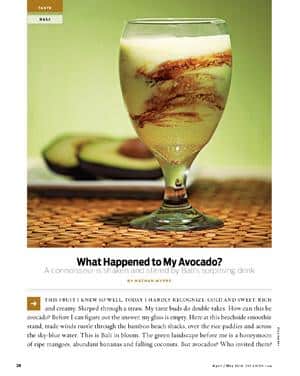Taste: Bali's Avocados
This fruit I knew so well, today I hardly recognize. Cold and sweet. Rich and creamy. Slurped through a straw. My taste buds do double takes. How can this be avocado? Before I can figure out the answer, my glass is empty. Here at this beachside smoothie stand, trade winds rustle through the bamboo beach shacks, over the rice paddies and across the sky-blue water. This is Bali in bloom. The green landscape before me is a honeymoon of ripe mangoes, abundant bananas and falling coconuts. But avocados? Who invited them?
I order another green smoothie. This time, I watch the young server make it. I grew up in the avocado capital of the world. Before trading the temperate carpool lanes of San Diego for the equatorial potholes of Bali, I wrote a book about guacamole. I've served hummus guacamole on warm pita crisps, crab guacamole in chilled martini glasses and beer-battered sauerkraut guac on Bavarian black-bread crostini. I am no stranger to avo-experimentation. But somehow this shake has me rattled.
Milk? Sugar? Ice? Sacrilege. The blender grates its disapproval then changes its tune to a fluid purr. "Mau chocolate?" the server asks. Do I want chocolate in my frozen guacamole drink? Now I can't even remember what avocado tastes like. Yes. I want chocolate.
She rolls the glass under a stream of cool, dark indulgence, oozing in anticipation of the shamrock slush. I just barely restrain myself from ripping the shake out of her hands.
I had avoided these drinks on earlier visits to Indonesia. Laughed at them even. The smoothie menu read like a trick question: Mango. Banana. Pineapple. Avocado ... busted.
Nutty and oily rather than juicy and sweet, avos always had a tough time pulling "local" status among other tropical nectars. You don't just pluck an avo from the tree and sink your teeth in on a hot afternoon. Avocados need to be ripened, coddled ... loved. Avocados need people.
Even since the disappearance of the dinosaurs, avocados have depended largely on mankind for their propagation. Imagine a featherweight seabird ingesting a golf-ball-size seed before flying to some distant shore to fertilize and plant it. Not gonna happen. So it wasn't until the first conquistadors planted their flag in the Aztecs' favorite fruit that avos began their world travels.
The hardy trees fared well at sea, yielding rich, fatty fruits as a fresh, creamy spread for the sailors' daily hard-tack bread. Called midshipmen's butter, avocados became regular passengers aboard trade ships of every nation, with shore leave in Europe, Asia, India and, eventually, Indonesia.
On the island of Java, the smooth, shiny alpuket leaves are boiled as a treatment for kidney stones. On Sumatra, the dark-green buah pokot mash is brewed with coffee extract for a morning kicker. And on Sumbawa, the brownish apocat is used as a seasoning paste for grilled fish. In a region with more than 17,000 islands and a revolving cast of governing nations, avocados struggled to find their true colors in the kaleidoscope of Indonesian cuisine. It wasn't until the Hindu-flavored island of Bali developed as a booming tourist destination that avocados discovered their hidden talent for the dessert menu.
Before my beach smoothies, I dined at the poolside restaurant of a posh hotel, where a waiter told me the legend of Indonesia's famous avocado dessert, es teler. "The name literally means 'wasted,'" he grinned. "The bartender that night, he was very tired when he mixed together avocado, jackfruit, coconut, ice and ..." He paused on the final word, grasping for translation. "Krim manis," he said. Sweet cream. Condensed milk: the cotton candy of dairy products. I've seen adult Indonesians drink it straight from the can. Cringe.
Creation myths aside, es teler quickly became a national treasure, inspiring a Dairy Queen-like chain of Es Teler '77 restaurants throughout the islands and into Australia and Singapore.
Meanwhile, a simplified version of the treat eased its way onto the menus of both posh hotels and bamboo beach shacks — just hanging out with the other tropical fruits on the smoothie menu.
Here on the beach, halfway through my second green shake, I'm feeling the effects of the avocados. They're rich, fatty and oily. Smoothie-certified or not, avos are heavy. And I'm full.
I fan myself with the laminated menu. It includes spaghetti Bolognese, Aussie-style cheeseburgers, wood-fire pizzas. Bali cuisine is tourist cuisine. The customer is always right — unless he wants Mexican food. When you do discover the rare taco stand in this part of the world, it's inevitably run by some California expat swapping lemons for limes, white rice for black beans and homesick cravings for authentic ability. Avos and limes: yes. Guacamole: no.
Still, being a California expat myself, I have always considered opening my own Indo taco shack — the best guac in all of Asia. But now I don't know. This avo shake has me thinking about a new dream. And my taco-stand idea could be a bit wobbly. I mean, really, guacamole is primarily a dessert drink, right?
